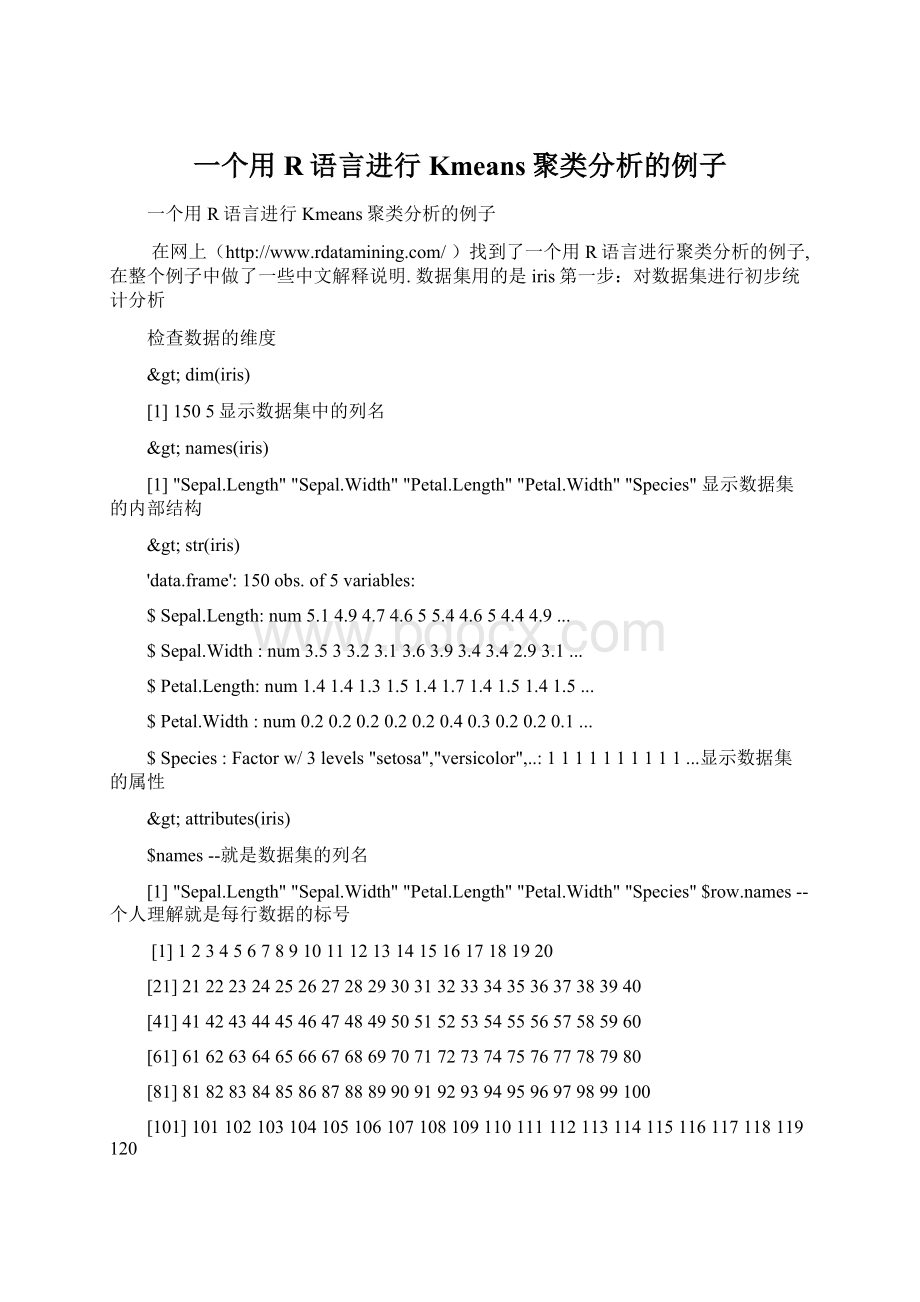一个用R语言进行Kmeans聚类分析的例子.docx
《一个用R语言进行Kmeans聚类分析的例子.docx》由会员分享,可在线阅读,更多相关《一个用R语言进行Kmeans聚类分析的例子.docx(4页珍藏版)》请在冰豆网上搜索。

一个用R语言进行Kmeans聚类分析的例子
一个用R语言进行Kmeans聚类分析的例子
在网上()找到了一个用R语言进行聚类分析的例子,在整个例子中做了一些中文解释说明.数据集用的是iris第一步:
对数据集进行初步统计分析
检查数据的维度
>dim(iris)
[1]1505显示数据集中的列名
>names(iris)
[1]"Sepal.Length""Sepal.Width""Petal.Length""Petal.Width""Species"显示数据集的内部结构
>str(iris)
'data.frame':
150obs.of5variables:
$Sepal.Length:
num5.14.94.74.655.44.654.44.9...
$Sepal.Width:
num3.533.23.13.63.93.43.42.93.1...
$Petal.Length:
num1.41.41.31.51.41.71.41.51.41.5...
$Petal.Width:
num0.20.20.20.20.20.40.30.20.20.1...
$Species:
Factorw/3levels"setosa","versicolor",..:
1111111111...显示数据集的属性
>attributes(iris)
$names--就是数据集的列名
[1]"Sepal.Length""Sepal.Width""Petal.Length""Petal.Width""Species"$row.names--个人理解就是每行数据的标号
[1]1234567891011121314151617181920
[21]2122232425262728293031323334353637383940
[41]4142434445464748495051525354555657585960
[61]6162636465666768697071727374757677787980
[81]81828384858687888990919293949596979899100
[101]101102103104105106107108109110111112113114115116117118119120
[121]121122123124125126127128129130131132133134135136137138139140
[141]141142143144145146147148149150$class--表示类别
[1]"data.frame"查看数据集的前五项数据情况
>iris[1:
5,]
Sepal.LengthSepal.WidthPetal.LengthPetal.WidthSpecies
15.13.51.40.2setosa
24.93.01.40.2setosa
34.73.21.30.2setosa
44.63.11.50.2setosa
55.03.61.40.2setosa查看数据集中属性Sepal.Length前10行数据
>iris[1:
10,"Sepal.Length"]
[1]5.14.94.74.65.05.44.65.04.44.9同上
>iris$Sepal.Length[1:
10]
[1]5.14.94.74.65.05.44.65.04.44.9显示数据集中每个变量的分布情况
>summary(iris)
Sepal.LengthSepal.WidthPetal.LengthPetal.WidthSpecies
Min.:
4.300Min.:
2.000Min.:
1.000Min.:
0.100setosa:
50
1stQu.:
5.1001stQu.:
2.8001stQu.:
1.6001stQu.:
0.300versicolor:
50
Median:
5.800Median:
3.000Median:
4.350Median:
1.300virginica:
50
Mean:
5.843Mean:
3.057Mean:
3.758Mean:
1.199
3rdQu.:
6.4003rdQu.:
3.3003rdQu.:
5.1003rdQu.:
1.800
Max.:
7.900Max.:
4.400Max.:
6.900Max.:
2.500显示iris数据集列Species中各个值出现频次
>table(iris$Species)setosaversicolorvirginica
505050根据列Species画出饼图
>pie(table(iris$Species))算出列Sepal.Length的所有值的方差
>var(iris$Sepal.Length)
[1]0.6856935算出列iris$Sepal.Length和iris$Petal.Length的协方差
>cov(iris$Sepal.Length,iris$Petal.Length)
[1]1.274315算出列iris$Sepal.Length和iris$Petal.Length的相关系数,从结果看这两个值是强相关。
>cor(iris$Sepal.Length,iris$Petal.Length)
[1]0.8717538画出列iris$Sepal.Length分布柱状图
>hist(iris$Sepal.Length)画出列iris$Sepal.Length的密度函数图
>plot(density(iris$Sepal.Length))画出列iris$Sepal.Length和iris$Sepal.Width的散点图
>plot(iris$Sepal.Length,iris$Sepal.Width)绘出矩阵各列的散布图
>plot(iris)
or
>pairs(iris)第二步:
使用knn包进行Kmean聚类分析将数据集进行备份,将列newiris$Species置为空,将此数据集作为测试数据集
>newiris<-iris
>newiris$Species<-NULL在数据集newiris上运行Kmean聚类分析,将聚类结果保存在kc中。
在kmean函数中,将需要生成聚类数设置为3
>(kc<-kmeans(newiris,3))
K-meansclusteringwith3clustersofsizes38,50,62:
K-means算法产生了3个聚类,大小分别为38,50,62.Clustermeans:
每个聚类中各个列值生成的最终平均值
Sepal.LengthSepal.WidthPetal.LengthPetal.Width
15.0060003.4280001.4620000.246000
25.9016132.7483874.3935481.433871
36.8500003.0736845.7421052.071053Clusteringvector:
每行记录所属的聚类(2代表属于第二个聚类,1代表属于第一个聚类,3代表属于第三个聚类)
[1]111111111111111111111111111111111111
[37]111111111111112232222222222222222222
[73]222223222222222222222222222232333323
[109]333332233332323233223333323333233323
[145]332332Withinclustersumofsquaresbycluster:
每个聚类内部的距离平方和
[1]15.1510039.8209723.87947
(between_SS/total_SS=88.4%)组间的距离平方和占了整体距离平方和的的88.4%,也就是说各个聚类间的距离做到了最大Availablecomponents:
运行kmeans函数返回的对象所包含的各个组成部分
[1]"cluster""centers""totss""withinss"
[5]"tot.withinss""betweenss""size"
("cluster"是一个整数向量,用于表示记录所属的聚类
"centers"是一个矩阵,表示每聚类中各个变量的中心点
"totss"表示所生成聚类的总体距离平方和
"withinss"表示各个聚类组内的距离平方和
"tot.withinss"表示聚类组内的距离平方和总量
"betweenss"表示聚类组间的聚类平方和总量
"size"表示每个聚类组中成员的数量)创建一个连续表,在三个聚类中分别统计各种花出现的次数
>table(iris$Species,kc$cluster)
123
setosa0500
versicolor2048
virginica36014根据最后的聚类结果画出散点图,数据为结果集中的列"Sepal.Length"和"Sepal.Width",颜色为用1,2,3表示的缺省颜色
>plot(newiris[c("Sepal.Length","Sepal.Width")],col=kc$cluster)
在图上标出每个聚类的中心点
〉points(kc$centers[,c("Sepal.Length","Sepal.Width")],col=1:
3,pch=8,cex=2)